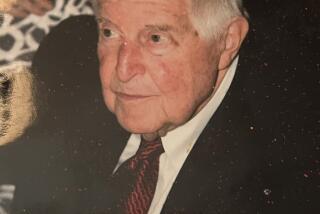Retired congressman dubbed ‘Mr. Health’
- Share via
Paul G. Rogers, a retired congressman known as “Mr. Health” for his work on environmental and healthcare legislation during 24 years as a Democratic representative from West Palm Beach, Fla., died Monday at Sibley Memorial Hospital in Washington, D.C. He was 87 and had lung cancer.
Rogers chaired the House Subcommittee on Health and the Environment, was the main sponsor of the Clean Air Act of 1970 and mobilized federal research into a “war on cancer.”
He also was the leader of legislation that established the National Institute of Aging and set standards for safe drinking water, noise control and emergency medical services.
Rogers worked on legislation that made used cars adhere to federal safety requirements and examined the impact of X-rays from color television sets. He pushed the Food and Drug Administration to improve its inspections of food plants and medical devices.
He also passed a comprehensive drug abuse and prevention act as well as the Medicare-Medicaid Anti-Fraud and Abuse Amendments of 1977.
Rogers was the chief sponsor in 1968 of legislation endorsed by the Johnson administration to crack down on individual users of amphetamines, barbiturates and LSD, which for the first time made it a misdemeanor to possess the drugs for one’s own use.
The bill passed, but another proposed drug ban didn’t. Dieters and diabetics in 1977 inundated Rogers and other officials with protests as Congress considered a ban on the artificial sweetener saccharine when early animal studies connected it to increased incidence of cancer.
Rogers was an advocate of healthy habits and did not smoke, his friends said.
In a 1979 interview, the Palm Beach Post reported that he said, “I saw the potential for what could be done in the healthcare field, and it just was not being aggressively pursued. We were not looking ahead and planning.”
That concern for planning led to his widely quoted statement, “Without research, there is no hope,” now set in a marker on the National Institutes of Health campus.
Since leaving Congress in 1979, Rogers had been a partner in the Washington law firm Hogan & Hartson, where he started the firm’s health law practice.
He served on numerous boards, including the American Cancer Society, Cleveland Clinic Foundation and Rand Corp. He was a past board chairman of the National Osteoporosis Foundation, Research!America and the Scripps Research Institute.
The main plaza at the National Institutes of Health was named for him in 2001. The federal courthouse in West Palm Beach also bears his name.
Paul Grant Rogers was born in Ocilia, Ga., on June 4, 1921, and moved to Fort Lauderdale, Fla., as a child. He graduated from the University of Florida in 1942 and served in the Army during World War II, receiving the Bronze Star for his actions in the European theater.
He graduated from the University of Florida’s law school in 1948 and practiced law in Palm Beach until 1955, when he won a special election to fill the congressional seat held by his father, Dwight Rogers, who had died.
Florida’s 9th Congressional District, then one of the largest in the nation as measured by geography, is now divided into 10 districts. The younger Rogers was reelected 11 times, often without opposition, and in his last campaign he won 91% of the vote.
He is survived by his wife of 46 years, Rebecca; a daughter, Rebecca Laing Sisto of Westfield, N.J.; a brother; and four grandchildren.
More to Read
Get the L.A. Times Politics newsletter
Deeply reported insights into legislation, politics and policy from Sacramento, Washington and beyond. In your inbox twice per week.
You may occasionally receive promotional content from the Los Angeles Times.










